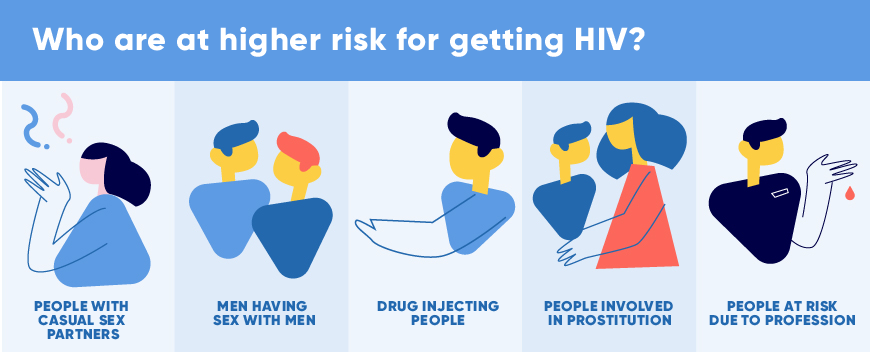Who are at higher risk for getting HIV?

The risk is higher for people who exhibit risk behaviour. They should get tested for HIV at least once a year.
People with casual sex partners
You are risking HIV if you have unprotected sex with someone you cannot be sure doesn’t have HIV. It is not possible to determine your partner’s HIV status based on their appearance. To assess the risk involved it is not enough to know the person more or less. A person with HIV exhibits no visible symptoms. The person himself or herself may not even be aware of having been infected. Having unprotected sex just once is enough to get infected. So be sure to always use a condom when having sex with a casual partner. After unprotected sex you should get tested for HIV just to be sure.
Men having sex with men
The most common way of sexual transmission of HIV is through anal sex, which means that men having sex with men are more likely to be exposed to the virus.
Drug injecting people
One of the ways of transmitting HIV is by injection with infected needles, and puncture wounds and cuts – all actions whereby an infected sharp object or infected bodily fluids come into contact with the blood circulation of someone who is not infected. People at high risk for getting HIV are those who inject drugs using a syringe or a needle already used by someone else.
People involved in prostitution
The risk of getting HIV is increased by a high number of sex partners and casual use of protection.
If you are involved in prostitution, it is in the interests of your health for you to always use protection when having sex, with no exceptions. You should get tested regularly so you could start treatment right away should you get infected.
When you develop the desire to buy sex, you should think it through whether it is worth the risk of getting HIV. If you nonetheless decide to take that risk, be sure to use protection and get tested for HIV afterwards.
People at risk due to profession
The risk of getting HIV at work may arise in various situations, for instance when infected blood enters an open wound or mucous membranes or when getting pierced with a syringe or another object that has fresh blood on it. Those at risk due to their profession are considered to be people who run the risk of being exposed to potentially infectious bodily fluids in their everyday duties (police officers, rescue workers, paramedics, prison officers, health care professionals and so on).
Since people are not obligated to reveal their infections and they themselves may be oblivious to the fact, everyday duties must be carried out assuming that everyone’s blood or other bodily fluids may be infectious. That is why it is necessary to follow all safety requirements and use personal protective equipment to avoid getting infected.
While the most important thing is to avoid getting infected in the working environment, prophylactic treatment has also been developed for cases when a person comes into contact with infectious material.
Every case of possible infection must be reported to one’s immediate supervisor and the working environment specialist, the case of exposure must be registered and an appointment with an infectious disease doctor must be made. The infectious disease doctor will assess the risk of infection, order necessary tests and decide whether there is need for prophylaxis. Full confidentiality must be ensured for employees in cases of exposure. Employees have the right to continue work after exposure. According to the laws of Estonia, the person responsible for the safety of employees (training, personal protective equipment and so on) is the employer.

